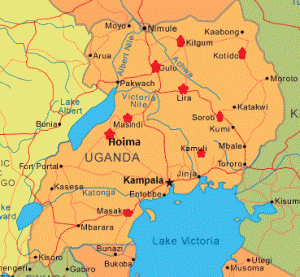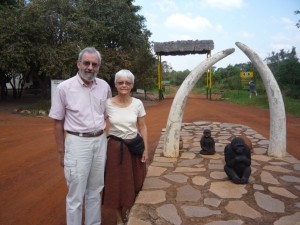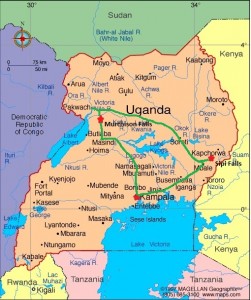January 26th, 2012
We recently participated part-time in a 5-day leadership institute in Kampala, Uganda, offering participants an opportunity to interact with and learn from Christian leaders from the “Great Lakes” region of East Africa. The Institute is organized by the Center for Reconciliation of Duke University and has been supported by World Vision, ALARM (African Leadership and Reconciliation Ministries), and MCC. About 120 Christian leaders (inter-confessional, Catholic and Protestant of many varieties) from Burundi, DRC, Kenya, Rwanda, South Sudan, Tanzania, and Uganda came together for a time of rest, community, and learning rooted in the biblical vision of reconciliation. This region of Africa has experienced (and is experiencing) some of the worst cases of civil unrest, war, genocide and poverty. The struggle continues for peace, healing, social transformation and reconciliation.
The Institute was held at Ggaba National Catholic Seminary with its restful green lawns, trees, and brick buildings southeast of Kampala city center. Mornings began with worship, followed by a plenary session, morning tea, and another plenary session. All sessions were held in English and French. Lunch was a slightly longer break during which time Sally Jo ran a book table for the participants. We left after this to return to the office to get some needed MCC work done. At the Seminary there were seminars for the participants and worship ended the day. There was a pilgrimage to Namugongo Uganda Martyrs’ Shrine one day. (We have now been there four times and hopefully that will be the subject of our next blog!)
Posted in Uganda | No Comments »
January 22nd, 2012
 Back in March we had a short blog about one of our partners—Living with shalom—based in Hoima. Every January groups of youth from various parts of Uganda are brought together for 3 weeks of learning what it means to “live with shalom” within themselves, with others, and with God. There are six young people from nine different areas of the country—Masaka, Hoima, Masindi, Kitgum, Gulu, Lira, Kotido, Soroti, and Kamuli. These represent different ethnic groups.
Back in March we had a short blog about one of our partners—Living with shalom—based in Hoima. Every January groups of youth from various parts of Uganda are brought together for 3 weeks of learning what it means to “live with shalom” within themselves, with others, and with God. There are six young people from nine different areas of the country—Masaka, Hoima, Masindi, Kitgum, Gulu, Lira, Kotido, Soroti, and Kamuli. These represent different ethnic groups.
They work at peace by breaking down stereotypes of others and learning how to deal with conflict. They work at peace with themselves through life skills and learning about HIV Aids. They work at peace with the environment through conservation, especially in the form of energy-efficient stoves and the planting of trees. They make three field trips during these weeks. This year they visited a resettlement area, an orphanage, and Murchison Falls National Park.
At the end of the three weeks they have a celebration which we attended. The day began with a parade, including a police escort and a small band, through the town of Hoima. During the parade they carry signs encouraging acceptance of those with HIV Aids, warning against deforestation, and asking people not to litter. As they moved through town they picked up the trash. In the afternoon there were dances, songs, and skits by the various groups. (Dancers do not hold still; so yes, our photos are blurry!) There was one skit about accepting those who often are not accepted—prisoner, HIV victim, disabled and another skit about domestic violence. The day ended with the obligatory speeches!
During the day we had a chance to talk with some of the participants. One said that before these weeks, he didn’t know people from other parts of the country and was even suspicious or afraid of them. Now he has friends wherever he goes! The significance of this statement cannot be underestimated in a country where loyalty to clan or ethnic group tends to far exceed loyalty to the country.
This three-week training will be followed by reciprocal visits during the coming year by the groups of youth to each other’s home areas.
Posted in Uganda | No Comments »
January 15th, 2012
While staying at Sipi Falls we made a visit to a small Women’s Coffee Cooperative nearby. We saw the process from the initial seedlings to the final roasting. (We forgot to take photos of all the steps!) It takes about three years for a coffee seedling to grow and produce coffee. Here on the mountain the seedlings are often intercropped with banana plants. After picking the coffee berries, the outer shell is removed and a moist bean is revealed. These beans are then laid out to dry. They are pounded to remove another shell and then roasted in a pot over an open fire.
As we watched the roasting the community children enjoyed looking at these “wazungu” (us) and seeing the photos that we took of them.
Posted in Uganda | No Comments »
January 14th, 2012
In September we had spent two nights at Sipi Falls, on the side of Mount Elgon in eastern Uganda. We enjoyed it so much that we returned with Michelle and Andrea. It is a beautiful spot. At one point Michelle told the guide that it looked like the beginning of the world. He smiled and said that many people say that. Local people say the God spent much time and took great care in his creation in this beautiful spot—then rested a bit and took it a little easier when creating the plains.
There are three falls associated with the name Sipi Falls. The first can be seen from the grounds of the lodge where we were staying. We hiked to the upper two falls—lovely. In the afternoon we also visited a nearby naturally-formed cave. It now contains many bats which we could hear but which would not remain still for photos!
Posted in Uganda | No Comments »
January 8th, 2012
 During the month of December we had two opportunities to visit a popular game viewing area at Murchison Falls. At the beginning of the month we were there with Sally Jo’s brother and nephew, Gerald and Steve Miller, and at the end of the month we went again with our daughters Michelle and Andrea.
During the month of December we had two opportunities to visit a popular game viewing area at Murchison Falls. At the beginning of the month we were there with Sally Jo’s brother and nephew, Gerald and Steve Miller, and at the end of the month we went again with our daughters Michelle and Andrea.
The falls themselves are located on a westward flowing section of the Victoria Nile. Much of the waters of the River Nile originate in Uganda. The Victoria Nile flows out of Lake Victoria, through Lake Kyoga, and empties into Lake Albert briefly before continuing into the Albert Nile that flows north into the White Nile that eventually passes through Khartoum and Cairo. Murchison Falls are quite spectacular, especially from the top, because at that point a large amount of water is forced through a very narrow gorge in the rock cliff.
On both visits our lodging was on the south side of the river, and we needed to take an early morning (7 am) ferry crossing for the best opportunity to see the animals on the north side. With Gerald and Steve we stayed at Sambiya River Lodge and heard cape buffalo feeding on the grass outside our rooms at night. With Michelle and Andrea we stayed at a “rest camp” and saw warthogs and hippos wandering through the grounds munching on the grass at night. They were literally right outside our windows!
After crossing the river on a small ferry, we took a game drive in our car for about 4 hours with a ranger/guide who helped us find and identify the animals and birds that we saw. Then we had lunch at Paraa Lodge on the north side of the river. After lunch we took a 3-hour boat trip to the base of the falls and observed many more animals and birds along the way. The entire stay was very interesting, and our guests all reported that it was a highlight of their time in Uganda.
Posted in Uganda | No Comments »
January 1st, 2012

We made a 5-day trip to Murchison Falls and Sipi Falls with Michelle and Andrea. (More later.) We had a great time seeing animals, the variety of Ugandan countryside, and several waterfalls. We arrived back in Kampala the afternoon of New Year’s Eve. Games, pumpkin soup for supper, and our usual oliebollen were our activities—along with watching fireworks exploding in various parts of the city and hearing music from our verandah.
More card games on New Year’s Day and then a visit to Ndere Center for buffet and dances. Happy New Year everyone!
Posted in Uganda | 1 Comment »
December 26th, 2011
Christmas this year was different in some ways but with some familiar experiences. Familiar—family, eating, candlelight service. Different – warm weather, new foods, new friends. We were happy that both Michelle and Andrea could join us here in Uganda.
Christmas Eve we attended service at All Saints Cathedral. It was wonderful to join in the familiar carols, hear the familiar readings, and end with the singing of Silent Night by candlelight. We came home and had supper at 10 p.m.
Christmas Day began with a brunch of pancakes and fresh fruit—pineapple, papaya, and bananas. We did some reminiscing as we found all our previous homes using Google Earth.
In the afternoon M, our house helper, invited us to join her family in fun and food. As we arrived the music system was being set up. We divided into four teams to compete in various contests. The first was a treasure hunt. The second was water balloon volleyball. What fun! There were disagreements of course and SJ served as “final” official for one. And there was a winner.
There was lots of food – all very good and all very different than our usual Christmas dinner.
We ended our day with a call to the rest of our family by Skype. Isn’t Skype wonderful!
Posted in Uganda | No Comments »
December 20th, 2011
What’s an “ordinary” day like for us? When we are in town, we never know for sure what the day will hold, but there are some common things that usually happen.
First of all there is the drive to the office—about 2-3 km (not quite 1 mile)—which can take 10-20 minutes, depending on the traffic. As we leave our house we often encounter cows or goats or chickens –and always bicycles and motorbikes (called boda boda) as well as cars. There is a view across the valley to the hill where the office is located. We pass many little shops along the way. There are three corners that are usually congested.
After we make our first turn we can see ahead—to the traffic and to the local market. We pass a “washing bay” along the way as well as a “hardware” shop. The market has busy vendors along the road getting ready for the day. More congestion and we are at the office.
Monday mornings we spend time in devotions and on catching up with each other’s activities. Our song this week was in Luo:
Ipoore me amara (x4) You are worthy to be loved
Ipoore me awora (x4) You are worthy to be praised
Ipoore Rwot Ipoore (x4) You are worthy
Obanga tima Kica (x4) Lord have mercy
We work at our computers much of the day—writing and responding to email, reading, responding to, and writing reports, entering data in the MCC database, working on financial items. We may have visitors and discuss MCC’s program and partner locations. We may work at organizing papers and boxes from the last 25 years. We may hear a band marching down the street or spend some time watching the new building going up across the street.
Uganda has rolling blackouts. Up until about 2 months ago, when power went off suddenly in the office, we would be caught with “unsaved” files on our computers. We recently purchased new inverter batteries that kick on when power goes off. It has been a big help.
Lunch is usually at a nearby spot. At the end of the day, we again face the traffic. We often go home a slightly different route, but the congestion is all the same! And Daisy is very happy when we arrive home!
Posted in Uganda | 3 Comments »
December 15th, 2011
We recently spent a wonderful 8 days with Sally Jo’s brother and son here in Uganda. We visited many sites, relaxed, played lots of Canasta, found our way through traffic and crowded streets, and generally had a good time. Included in this blog are representative photos of the various places we went. Most of the sites need a blog entry themselves.
We visited the two oldest cathedrals in Kampala – Church of Uganda (Anglican) and Catholic and also two Hindu Temples. We saw some of the Buganda royal tombs and visited Namugongo Martyrs’ Shrine that honors Catholic and Anglican martyrs killed by the Baganda king in the late 1800’s. In Kampala we also made our way through a very small part of one of the largest open-air markets in East Africa. We visited two MCC projects in the city – Mengo Hospital Aids Clinic and Hope Prison Foundation. And of course, we did some craft shopping. Fried grasshoppers are a specialty and S thought he would try them. We all tasted them. They are sort of like popcorn!
Probably the highlight of the week was a three day safari to Murchison Falls. We saw all the major animals and many birds—and of course, the beautiful falls themselves. The Nile River crashes over the Murchison Falls and creates fantastic scenes both from the top of the falls and from the River below.
Stay tuned for later blogs with more detail—Namugongo, religious institutions, historical spots, and of course, much more of Murchison Falls Park.
Posted in Uganda | No Comments »
December 4th, 2011
 We spent our last day in Spain in Granada, a city at the foot of the Alhambra and the foot of the Sierra Nevada Mountains. Its history includes the Romans, the Moors, the Jews, and the Catholics. Architecture in the city is reminiscent of all these cultures. We spent most of our time in the Albayzín section of the city, with its narrow streets, Arabic influence, and small shops. (Ron was constantly intrigued with the various patterns in both Granada and the Alhambra.) We were entertained at several spots with musicians and a flamenco dancer.
We spent our last day in Spain in Granada, a city at the foot of the Alhambra and the foot of the Sierra Nevada Mountains. Its history includes the Romans, the Moors, the Jews, and the Catholics. Architecture in the city is reminiscent of all these cultures. We spent most of our time in the Albayzín section of the city, with its narrow streets, Arabic influence, and small shops. (Ron was constantly intrigued with the various patterns in both Granada and the Alhambra.) We were entertained at several spots with musicians and a flamenco dancer.
We also partook of the ever-present tapas and traditional hot chocolate and churros. We all decided that this is a spot we would like to return to some day!
Posted in Spain | No Comments »
















































































































































































































































































